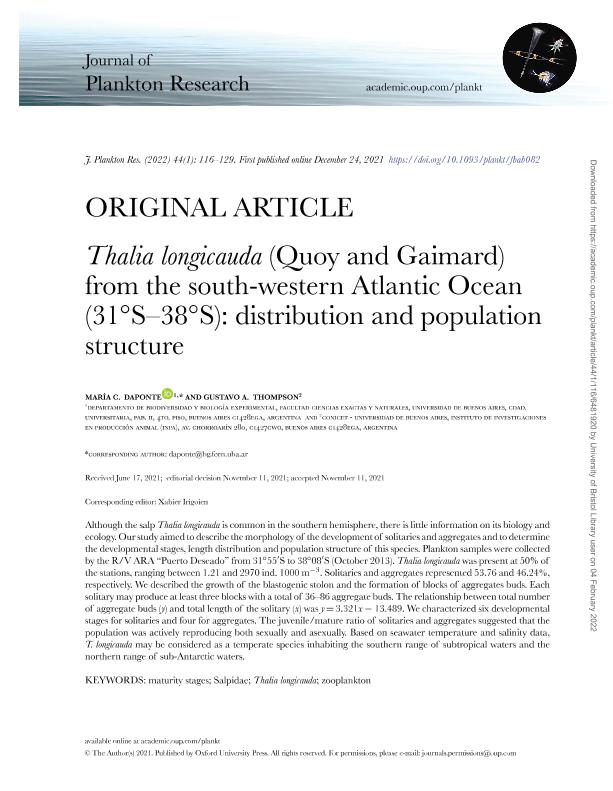Artículo
Thalia longicauda (Quoy and Gaimard) from the south-western Atlantic Ocean (31◦S-38◦S): distribution and population structure
Fecha de publicación:
24/12/2021
Editorial:
Oxford University Press
Revista:
Journal of Plankton Research
ISSN:
0142-7873
Idioma:
Inglés
Tipo de recurso:
Artículo publicado
Clasificación temática:
Resumen
Although the salp Thalia longicauda is common in the southern hemisphere, there is little information on its biology and ecology. Our study aimed to describe the morphology of the development of solitaries and aggregates and to determine the developmental stages, length distribution and population structure of this species. Plankton samples were collected by the R/V ARA “Puerto Deseado” from 31◦55'S to 38◦08'S (October 2013). Thalia longicauda was present at 50% of the stations, ranging between 1.21 and 2970 ind. 1000 m−3. Solitaries and aggregates represented 53.76 and 46.24%, respectively. We described the growth of the blastogenic stolon and the formation of blocks of aggregates buds. Each solitary may produce at least three blocks with a total of 36-86 aggregate buds. The relationship between total number of aggregate buds (y) and total length of the solitary (x) was y = 3.321x − 13.489. We characterized six developmental stages for solitaries and four for aggregates. The juvenile/mature ratio of solitaries and aggregates suggested that the population was actively reproducing both sexually and asexually. Based on seawater temperature and salinity data, T. longicauda may be considered as a temperate species inhabiting the southern range of subtropical waters and the northern range of sub-Antarctic waters.
Palabras clave:
MATURITY STAGES
,
SALPIDAE
,
THALIA LONGICAUDA
,
ZOOPLANKTON
Archivos asociados
Licencia
Identificadores
Colecciones
Articulos(INPA)
Articulos de UNIDAD EJECUTORA DE INVESTIGACIONES EN PRODUCCION ANIMAL
Articulos de UNIDAD EJECUTORA DE INVESTIGACIONES EN PRODUCCION ANIMAL
Citación
Daponte, María Cristina; Thompson, Gustavo Ariel; Thalia longicauda (Quoy and Gaimard) from the south-western Atlantic Ocean (31◦S-38◦S): distribution and population structure; Oxford University Press; Journal of Plankton Research; 44; 1; 24-12-2021; 116-129
Compartir
Altmétricas




